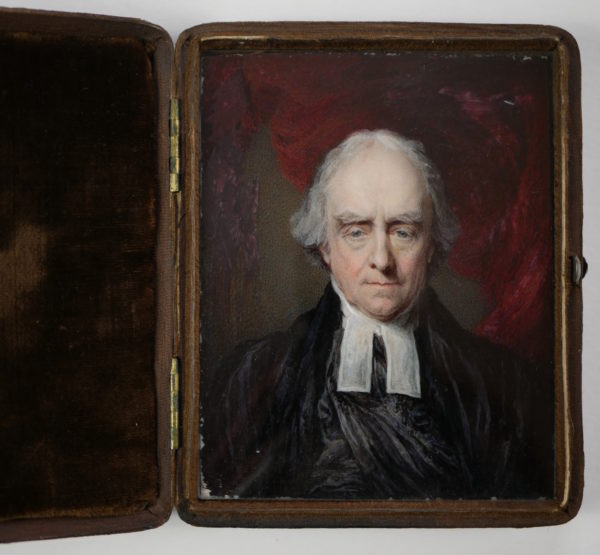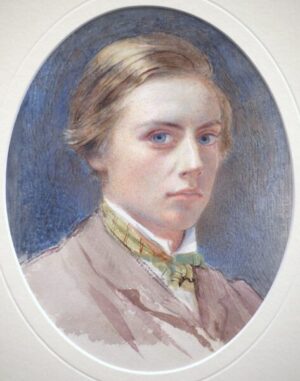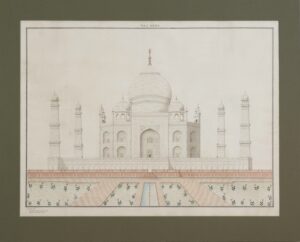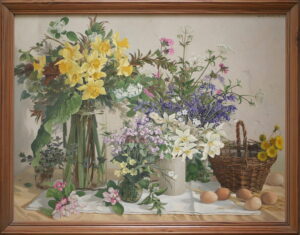Denning, Stephen Poyntz (1795-1864)
Stephen Poyntz Denning (1795-1864) was an English portrait painter and gallery curator. He studied drawing and painting under John Masey Wright, working from Wright's address from 1814 to 1817, before exhibiting oil and watercolour miniature portraits at the Royal Academy between 1814 and 1852, as well as a small number of oil genre scenes in 1844 at the British Institution. In 1821 he became Curator of the Dulwich Picture Gallery, a post he held until his death. He died at Dulwich and was buried on 10 June 1864 at West Norwood Cemetery.
The following account on Stephen Poyntz Denning was extracted from an online article published by Brian Green on Wednesday, 17 December 2014. The Dulwich Society; winter 2014. Artist in Residence - Stephen Poyntz Denning and the Herne Hill Art Set.
The early life of Stephen Poyntz Denning is something of a mystery. His father, Thomas Denning was born in Gloucestershire in 1767 and moved to Newington, Southwark where Stephen was born in 1795. There is no information regarding his mother. His middle name, Poyntz had customarily been used by the Denning family. There must have been some tragedy or misfortune early in Denning’s life. It was partially revealed, when soon after he was elected curator or custodian of the newly opened Dulwich College Picture Gallery he received a group of Royal Academician visitors, led by Joseph Farington and including Sir Thomas Lawrence. The reason for the visit was to inspect the pictures and select some to be copied by students at the Academy. Denning, who may already have been acquainted with Lawrence, got into conversation with them and clearly impressed Farington who wrote in his diary, “Mr Denning is an artist and excels in miniature painting. He gave us an account of his low extraction saying that when he was a boy, he was a beggar. He told us he acquired some knowledge of art - of his being an apprentice for 7 years to a person who employed him colouring prints. He informed us how he was enabled to go to Italy and the whole story of his progress is extraordinary....” Through what good offices we do not know, but the young Denning had been taken under the wing of the miniaturist artist John Wright. John Wright was well connected, being acquainted with the leading artists of the day such as John Hoppner as well as Lawrence. Stephen’s apprenticeship with Wright may have required him to spend seven years employed in colouring prints but he also learnt the art of miniature painting from his mentor. Denning lived with the family from 1814-17 in Burlington Gardens, perhaps as a companion to the Wright’s son, John William, 2 whose mother had died when he was an infant. John William was a delicate child; and had to be withdrawn because of his poor health from school at Loughborough House, Brixton. John William Wright was apprenticed to Thomas Phillips and became noted for his illustrations of characters from literature, especially Shakespearean subjects, many of which were engraved. After his own apprenticeship with John Wright, Denning travelled to Italy and had lodgings in both Bruton Street and Conduit Street, not then a fashionable area but a masculine one where single gentleman might find a room above the shops and ticket agencies. It was in one such agency that admission tickets for Dulwich College Picture Gallery might be obtained. Denning had his first painting, a miniature, accepted at the Royal Academy in 1814, when he was only 19 and still living with the Wrights. He had pictures accepted annually at the Academy until 1852, 48 in total. At some point he became the great friend of the artist and engraver John Burnet and co-operated with him by painting reduced size copies of Burnet’s oil paintings of both Chelsea and Greenwich pensioners for engraving purposes. In 1842, Burnet dedicated his Discourses of Sir Joshua Reynolds to Denning. In 1821, Denning succeeded Ralph Cockburn, the gallery’s first custodian, who had died the year previously. As well as being responsible for the collection, his job description included instructing in drawing, such of the poor scholars at the College as he recommended. He received a salary of 200 guineas per annum and accommodation. He was assisted by James Bonham who was paid £80 per year and had rooms in the former French Horn and had his livery supplied. The gallery was open daily except Fridays and Sundays and admission was free on production of a ticket. Perhaps inconveniently, tickets were only available in London at principal printsellers and bookshops It is not known how or when precisely, Denning came to the notice of the Royal Family, but the association certainly had started by 1823 when he painted the famous portrait of Princess Victoria aged 4. The painting was never engraved despite its significant popular appeal and remained in the artist’s possession. It was purchased by Dulwich Picture Gallery for 30 guineas in 1891 and immediately became the most popular picture in the collection. Another commission for the Royal Family, possibly by Denning, took place in 1825 when a miniature (6cm) of the future Queen Victoria was painted and inscribed: “Presented by the Princess Victoria to her dear old General Wetherell”. Wetherell was the ADC and equerry to the Duke of Kent, Victoria’s father. It seems likely that Denning was engaged by the household of the Duchess of Kent, which was at Kensington Palace, as a portrait by Denning exists (now in New York) of a sitter once believed to be Lucinda Bicknell, Elhanan Bicknell’s third wife, but now believed to be that of the Duchess herself. There has also been some discussion as to whether the painting of the infant Queen Victoria at Dulwich Picture Gallery is in fact that of her eldest daughter, also named Victoria and painted twenty years later. The fact that Denning’s style never altered throughout his career makes identification difficult. However, expert opinion comes down in favour of Queen Victoria. Other Royal commissions followed; William IV ordered a copy from Denning of Lawrence’s portrait of Sir Jeffry Wyatville, the architect and garden designer which was presented by the King to Wyatville. It was also engraved. Denning is also credited with painting a portrait of the future Prince Albert which is now in Gotha. Finally, in 1846 Queen Victoria commissioned a copy of Franz Xaver Winterhalter’s portrait of the Royal Family from Denning for a fee of over £200 and lithographs were made in Paris of the portrait, one of which was given to Louis Phillipe, perhaps as a ‘thank you’ to the French king for giving permission for Winterhalter, who was France’s court painter, to carry out the commission from Queen Victoria. Denning must have had an engaging personality because he made friends easily and widely among those living in Dulwich. One amusing observation is given in the diary of Joseph Romilly, a Cambridge academic and bachelor who lived at The Willows, on Dulwich Common. In December 1834 he unwisely attended the tea and supper party of his nephew, George Romilly. At first all went well, ”they danced 2 Quadrilles & a country dance - some very pretty fireworks of George Allen’s were let off extremely well by him - they lasted about an hour and a half. George Romilly appeared to great advantage, he danced very gracefully, did the honour of the table well and was altogether a complete gentleman - some of the children behaved like rude blackguards, these were the Pages, Denning and Warner. The young ladies were very correct”. Numerous Dulwich residents had their own, or their children’s portraits painted by Denning. They included the political radical and classical historian George Grote and his wife, who lived at Woodhall, the Rev John Vane, chaplain and 1st Fellow of the College and Ozias Linley the 4th Fellow who bequeathed his family portraits by Gainsborough to the Gallery. Indeed, it might have been the latter’s friendship with Denning which commanded this gift. Over the years Denning made numerous copies of pictures from the collection at Dulwich. A Murillo and a Rubens copy hang in the Cottonian Collection of Plymouth Art Gallery, and their donor, William Cotton and his wife’s portraits were also painted by Denning. In 1844 John Ruskin, who was a regular visitor to Dulwich College Picture Gallery received permission to make water colour copies of some of the collection. Both Ruskin and his father were part of the circle of friends and artists, which included Denning, who was also a family friend, who gathered at Carlton House on Herne Hill (now the site of Danecroft Road), the home of Elhanan Bicknell….



